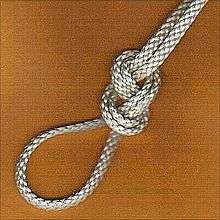Figure-eight loop
| Figure-eight loop | |
|---|---|
 | |
| Names | Figure-eight loop, Flemish loop |
| Category | Loop |
| Related | figure-eight knot, flemish bend, Figure-of-nine loop, spider hitch |
| Releasing | Jamming |
| Typical use | climbing, caving |
| Caveat | jams |
| ABoK | #1047 |
| Instructions | |
A figure-eight loop (also figure-eight on a bight or Flemish loop or Flemish eight) is a type of knot created by a loop on the bight. It is used in climbing and caving where rope strains are light to moderate and for decorative purposes. The knot is commonly followed by tying a strangle knot (a.k.a. half a double fisherman's knot) or an overhand knot around the standing end.[1]
The Flemish loop or figure-eight loop is perhaps stronger than the loop knot. Neither of these knots is used at sea, as they are hard to untie. In hooking a tackle to any of the loops, if the loop is long enough it is better to arrange the rope as a cat's paw.
The double figure eight is used to put a loop in the end of a rope, or around an object. It is relatively easy to tie and is secure, but can become difficult to untie after heavy loading, and can jam badly in any rope type.
Tying methods
Traditional

A figure-eight loop is created by doubling the rope into a bight, then tying the standard figure-eight knot.
Follow through
Alternatively, to tie the knot directly around an object, the follow through method must be used.
- Tie a regular figure eight knot with a significant amount of extra tail.
- Loop the tail around the object.
- Thread the tail back through the figure eight to create a normal looking figure eight on a bight.
See also
References
External links
- Grog. "Figure Eight Follow Through". Animated Knots. Retrieved April 2013. Check date values in:
|access-date=(help) - Photographs showing how to tie the figure of 8 loop knot
- http://notableknotindex.webs.com/figure8loop.html